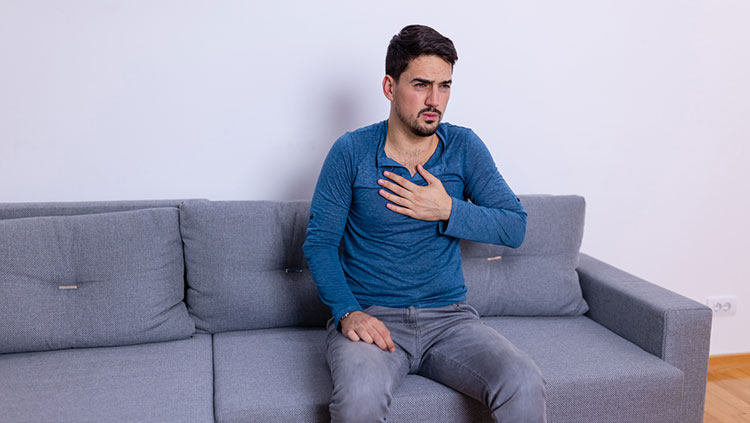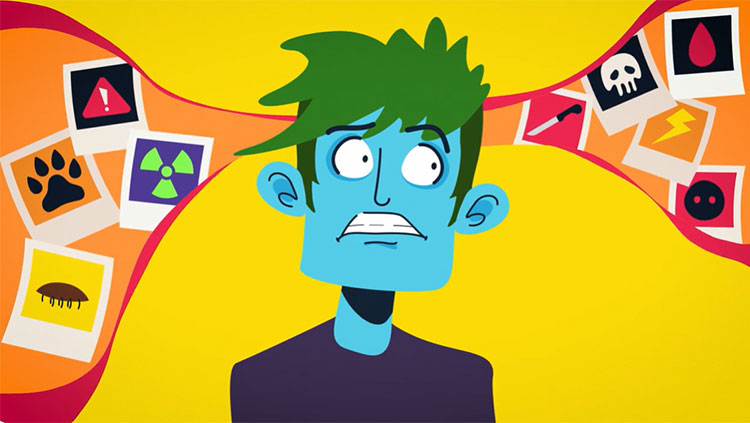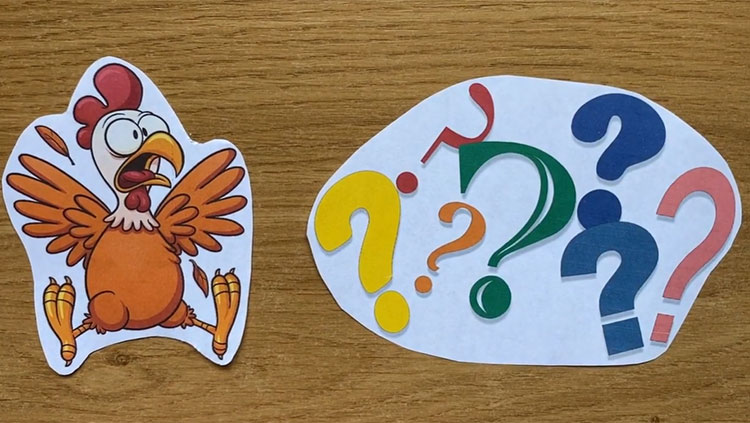Post-Traumatic Stress Disorder: An Overview
- Reviewed22 May 2023
- Author Alison Davis
- Source BrainFacts/SfN

Around half of all U.S. adults will experience at least one traumatic event in their lifetime. However, not all traumatic events will lead to post-traumatic stress disorder (PTSD): a condition that impacts around 6% of the U.S. population at some point in their lives.
PTSD is somewhat unique among psychiatric disorders in that it has a definitive cause: a traumatic event such as a natural disaster, military combat, a terrorist attack, a serious accident, physical assault, or sexual abuse. PTSD can develop immediately after such a distressing event, but it can also take months or years for symptoms to emerge. Symptoms are often debilitating enough to interfere with relationships or work. Some people have PTSD for many years, experiencing flashbacks and nightmares, intrusive memories of the traumatic event, and hyperarousal — feeling on edge and/or angry. To compensate, individuals with PTSD try to avoid known triggers but nonetheless may experience memory loss, feelings of blame, and decreased interest in everyday activities. Currently, cognitive behavioral therapy is thought to be the most effective treatment for PTSD.
Neuroscientists have discovered physiological changes in people with PTSD. These changes include increased heart rate, elevated sweat gland activity, and enhanced eye blink muscle contraction in response to audio or video triggers of traumatizing scenes like gunfire or other violence. Simply recalling the initial traumatic event can also bring on these symptoms. Another hallmark of PTSD is shallow sleeping with dysfunctional rapid eye movement (REM) sleep, which can lead to sleep deprivation over time. The body’s general response to stress is maximal in PTSD, with altered levels of hormones such as cortisol and norepinephrine, the primary fuels in the fight-or-flight response to danger or fear. Accordingly, PTSD treatment can sometimes include drugs that block norepinephrine, such as the blood-pressure medication prazosin and beta blockers like propranolol. Scientists have also detected low levels of other neurotransmitters such as serotonin in people with PTSD, leading to the use of selective serotonin reuptake inhibitors (SSRIs) for treatment. The neurotransmitter neuropeptide Y also appears to offer some protection against developing PTSD.
Neuroimaging studies have begun to reveal the neurobiological signatures of PTSD, including changes in brain structure. Many people with PTSD have a smaller hippocampus (the brain region integral for learning and memory) and a smaller prefrontal cortex (the part of the brain that helps control thinking, emotions, and behavior). In contrast, the brain’s emotional center, the amygdala, is apparently overactive in responding to stimuli in people with PTSD. Genes are involved in PTSD susceptibility, but research is not yet conclusive regarding the importance of their role or which genes are involved. What is clear, however, is that genes affecting PTSD risk also affect the risk for major depression, generalized anxiety disorder, or panic disorder — suggesting common biological components of these psychiatric conditions. Neuroimaging studies that pinpoint brain regions disrupted in PTSD support the development of new drugs targeting neural function in those regions. Among these drugs are cannabinoids, glutamate, and oxytocin — the latter of which is implicated in social bonding.
Adapted from the 8th edition of Brain Facts by Alison Davis.
If you or someone you know in the U.S. is struggling with self-harm or thoughts of suicide, visit or call the National Suicide Prevention Lifeline at 988 or 1-800-273-8255.
CONTENT PROVIDED BY
BrainFacts/SfN
References
American Psychiatric Association. (2023). Diagnostic and Statistical Manual of Mental Disorders (5th ed., text rev.). https://doi.org/10.1176/appi.books.9780890425787
Bandelow, B., & Michaelis, S. (2015). Epidemiology of anxiety disorders in the 21st century. Dialogues in Cclinical Nneuroscience, 17(3), 327–335. https://doi.org/10.31887/DCNS.2015.17.3/bbandelow
Burguière, E., Monteiro, P., Mallet, L., Feng, G., & Graybiel, A. M. (2015). Striatal circuits, habits, and implications for obsessive-compulsive disorder. Current Oopinion in Nneurobiology, 30, 59–65. https://doi.org/10.1016/j.conb.2014.08.008
Craddock, N., & Sklar, P. (2013). Genetics of bipolar disorder. Lancet (London, England), 381(9878), 1654–1662. https://doi.org/10.1016/S0140-6736(13)60855-7
Foland-Ross, L. C., Hamilton, P., Sacchet, M. D., Furman, D. J., Sherdell, L., & Gotlib, I. H. (2014). Activation of the medial prefrontal and posterior cingulate cortex during encoding of negative material predicts symptom worsening in major depression. Neuroreport, 25(5), 324–329. https://doi.org/10.1097/WNR.0000000000000095
Geddes, J. R., & Miklowitz, D. J. (2013). Treatment of bipolar disorder. Lancet (London, England), 381(9878), 1672–1682. https://doi.org/10.1016/S0140-6736(13)60857-0
Kavanagh, D. H., Tansey, K. E., O'Donovan, M. C., & Owen, M. J. (2015). Schizophrenia genetics: emerging themes for a complex disorder. Molecular Ppsychiatry, 20(1), 72–76. https://doi.org/10.1038/mp.2014.148
Memon, M. A. (2018). Panic Disorder. Medscape. http://emedicine.medscape.com/article/287913-overview
National Alliance on Mental Illness. (2017). Depression. https://www.nami.org/Learn-More/Mental-Health-Conditions/Depression
National Institute of Mental Health. (2017). Anxiety Disorders. NIH. https://www.nimh.nih.gov/health/topics/anxiety-disorders/index.shtml
National Institute of Mental Health. (2017). Bipolar Disorder. NIH. https://www.nimh.nih.gov/health/statistics/prevalence/bipolar-disorder-among-adults.shtml
National Institute of Mental Health. (2017). Depression. NIH. https://www.nimh.nih.gov/health/topics/depression/index.shtml
National Institute of Mental Health. (2017). Obsessive-Compulsive Disorder (OCD). NIH. https://www.nimh.nih.gov/health/topics/obsessive-compulsive-disorder-ocd/index.shtml
National Institute of Mental Health. (2017). Panic Disorder. NIH. https://www.nimh.nih.gov/health/statistics/prevalence/panic-disorder-among-adults.shtml
National Institute of Mental Health. (2017). Post-Traumatic Stress Disorder (PTSD). NIH. https://www.nimh.nih.gov/health/statistics/prevalence/post-traumatic-stress-disorder-among-adults.shtml
Pittenger, C., & Bloch, M. H. (2014). Pharmacological treatment of obsessive-compulsive disorder. The Psychiatric Cclinics of North America, 37(3), 375–391. https://doi.org/10.1016/j.psc.2014.05.006
Ragen, B. J., Seidel, J., Chollak, C., Pietrzak, R. H., & Neumeister, A. (2015). Investigational drugs under development for the treatment of PTSD. Expert Opinion on Investigational Drugs, 24(5), 659–672. https://doi.org/10.1517/13543784.2015.1020109
Strube, W., Bunse, T., Nitsche, M. A., Wobrock, T., Aborowa, R., Misewitsch, K., Herrmann, M., Falkai, P., & Hasan, A. (2015). Smoking restores impaired LTD-like plasticity in schizophrenia: a transcranial direct current stimulation study. Neuropsychopharmacology, 40(4), 822–830. https://doi.org/10.1038/npp.2014.275
Treadway, M. T., Waskom, M. L., Dillon, D. G., Holmes, A. J., Park, M. T. M., Chakravarty, M. M., Dutra, S. J., Polli, F. E., Iosifescu, D. V., Fava, M., Gabrieli, J. D. E., & Pizzagalli, D. A. (2015). Illness progression, recent stress, and morphometry of hippocampal subfields and medial prefrontal cortex in major depression. Biological Psychiatry, 77(3), 285–294. https://doi.org/10.1016/j.biopsych.2014.06.018
U.S. Department of Veterans Affairs. (2023). PTSD: National Center for PTSD. https://www.ptsd.va.gov/understand/common/common_adults.asp
World Health Organization. (2022). Mental disorders. https://www.who.int/news-room/fact-sheets/detail/mental-disorders
What to Read Next
Also In Emotions, Stress & Anxiety
Trending
Popular articles on BrainFacts.org



















